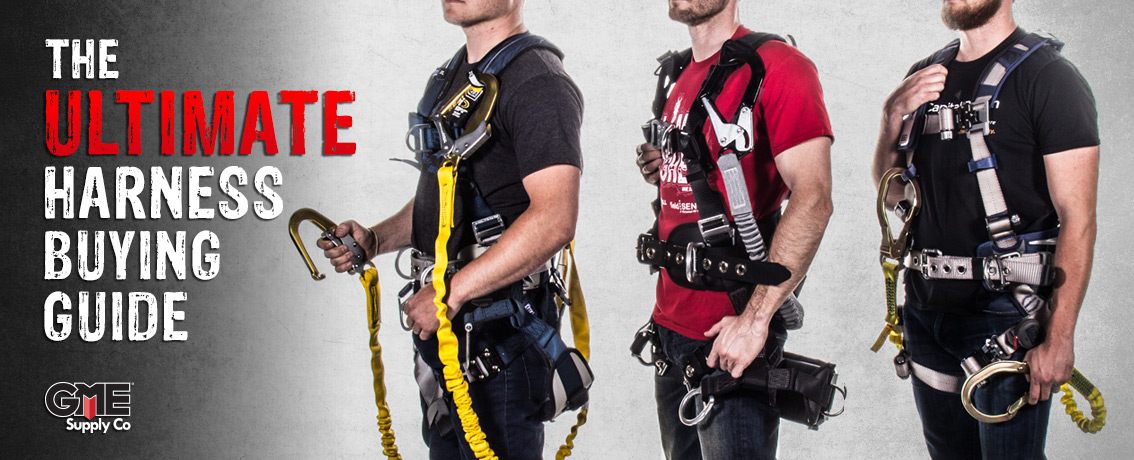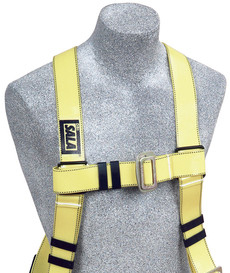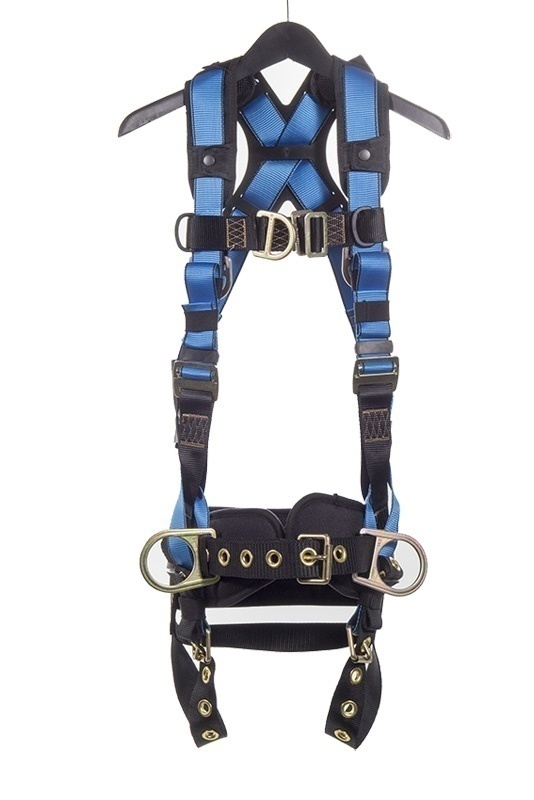The Ultimate Fall Protection Harness Buying Guide

So, you need to buy a new climbing harness, but you’re not quite sure where to start. We understand. There are a million different options and sometimes too many choices can be overwhelming. At GME we pride ourselves in being your Gear Experts® and this week we are outlining all of the information you need to make an informed decision about what harness you need to get the job done and stay safe.
Application
The first thing you want to do is narrow down the application that you need the harness for. This is most likely the easiest step of the buying process because your job will be specific. Some of the applications you will need a fall protection harness for are: • Tower Climbing • Tree Care (Aborist) • Solar Energy • Wind Energy • Construction Once you have the application narrowed down you then need to look at what type of specific job you are doing that may require specialized equipment. Specialty equipment includes: • Welding • Rope Access • Rescue
Material
Now it’s time to choose what kind of material the hardware (d-rings) is made of. Your two main options are steel and aluminum. Steel hardware is cheaper but also heavier. This can be a negative when you need to keep the total weight you are carrying below a certain limit (like when you are close to the weight limit of a lanyard or SRL). Aluminum, on the other hand, is more expensive but much lighter. There is a common misconception that aluminum is not as strong as steel, but the truth is that the aluminum parts have to pass the same tests that the steel parts do. While weight is one big determining factor about which harnesses to choose, compatibility is another one.
D-Rings, Connection Points, and Sizing
Now let’s look at some of the harness details that will affect your decision. How many D-Rings do you need? Do you need other connection points? What size is going to fit best? Well, we are here to help you answer all of these questions. Harnesses range from 1 to 6 D-Rings depending on your needs. For example, if you want to have the ability to position yourself with a positioning lanyard you will want a D-ring on each hip. Traditionally a tower climbing harness will have 6 D-rings whereas a construction harness will have between 1 and 3 D-rings. If you are unsure of how many D-Rings would be right for you, contact one of our Gear Experts®.
 You also want to consider additional connection points. Lanyard keepers allow you to conveniently hold your lanyards when they’re not in use while preventing them from swinging around or blowing in the wind. Keep in mind that additional accessory connection points are meant to be used for extra equipment not as fall protection points. This means that you should not use them to tie yourself off. It also means that they don’t have to be steel or aluminum. If weight is part of the equation many harnesses have connection points that are made of lighter materials.
You also want to consider additional connection points. Lanyard keepers allow you to conveniently hold your lanyards when they’re not in use while preventing them from swinging around or blowing in the wind. Keep in mind that additional accessory connection points are meant to be used for extra equipment not as fall protection points. This means that you should not use them to tie yourself off. It also means that they don’t have to be steel or aluminum. If weight is part of the equation many harnesses have connection points that are made of lighter materials.
Connection Points
There are three types of connection points when looking at harnesses. All connection points have the same function, to secure the harness to your body, and all of them meet the same requirements. What type of connection point you choose will be based on personal preference, convenience level, and price point. The three types of connections are:- Tongue buckle;
- Pass-through buckle; and
- Quick Connect (QC) buckle
 The tongue buckle is similar to the buckle system on a belt for your pants. There is a strap with grommets and you adjust the belt by pulling more material through the buckle and securing it in place with the prong. This is typically a cost-effective option when looking at your harness. But, keep in mind that while it is cost effective it may not be time effective. Having to manually work with the straps can increase the amount of time it takes you to gear up. Some people prefer tongue buckle because the straps do not loosen throughout the workday.
This WestFall Pro Ascend Tower Climbing Harness features tongue buckle leg straps.
Pass-through Buckle
The tongue buckle is similar to the buckle system on a belt for your pants. There is a strap with grommets and you adjust the belt by pulling more material through the buckle and securing it in place with the prong. This is typically a cost-effective option when looking at your harness. But, keep in mind that while it is cost effective it may not be time effective. Having to manually work with the straps can increase the amount of time it takes you to gear up. Some people prefer tongue buckle because the straps do not loosen throughout the workday.
This WestFall Pro Ascend Tower Climbing Harness features tongue buckle leg straps.
Pass-through Buckle
 The pass-through buckle also referred to as a parachute buckle, is a pretty simple system. There are two pieces of metal on each end of the buckle. The smaller end passes through the larger end and secures into place to attach the harness to your body. This type of connection point is the most economical connection between the three. It is typically found on many entry-level harnesses.
This DBI Sala Delta Vest-Style Harness features a pass-through chest buckle.
Quick Connect Buckle
The pass-through buckle also referred to as a parachute buckle, is a pretty simple system. There are two pieces of metal on each end of the buckle. The smaller end passes through the larger end and secures into place to attach the harness to your body. This type of connection point is the most economical connection between the three. It is typically found on many entry-level harnesses.
This DBI Sala Delta Vest-Style Harness features a pass-through chest buckle.
Quick Connect Buckle
 The Quick Connect buckle is the easiest and most efficient buckling system. It is similar to the way a seat belt works in a car. There is one end with a “tongued†edge and another with a clip. The tongue simply locks into the clip and you are ready for action. Many people prefer this type of connection point because it takes almost no time to ensure that your harness is securely attached to your body.
This Elk River Raven Tower Harness features a quick connect chest connection and a tongue buckle belt for seat attachment.
The Quick Connect buckle is the easiest and most efficient buckling system. It is similar to the way a seat belt works in a car. There is one end with a “tongued†edge and another with a clip. The tongue simply locks into the clip and you are ready for action. Many people prefer this type of connection point because it takes almost no time to ensure that your harness is securely attached to your body.
This Elk River Raven Tower Harness features a quick connect chest connection and a tongue buckle belt for seat attachment.
Certifications
When looking at full body harnesses it is important to keep in mind the certifications you need them to meet. If you are working in the United States you will need a harness that meets ANSI Z359.11-2014. ANSI Z359.11-2014 outlines the safety requirements for a full body harness. If you are working in Canada you will need a harness that meets the CSA requirements. Your CSA harness will need to meet the CSA Z259.10-12 Full Body Harness Standard. A full breakdown of these standards is beyond the scope of this blog post, but be sure to check back because we will cover it in another post. Also, subscribe to our YouTube channel to get notified when we break down the ANSI Z359.11 and CSA Z259.10-12 standard. Looking for more information about the standards? Give one of our Gear Experts® a call and as always Climb Higher®! Click here to view our full selection of safety harnesses.
Get Social
Be sure to follow us on social media to keep up with everything GME Supply has coming up in 2018. It will be exciting - we promise!
Facebook | Instagram | YouTube | Twitter | LinkedIn | Google+

Raven Tower Harness
Want to learn more about the Raven Tower Harness from Elk River? Check out this YouTube Video














